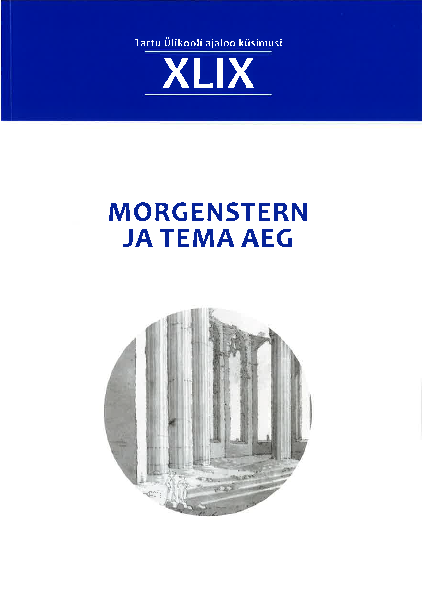Morgenstern ja Liphart. Kahe kunstitähe tegutsemisest samas ajas ja ruumis
Morgenstern and Liphart. Encounters of Two Art Stars Sharing a Time and Space
DOI:
https://doi.org/10.15157/tyak.vi49.18378Abstract
What do we know about and how can we describe the encounters
between Karl Morgenstern and the Lipharts, the Raadi lords of the
manor, who were the greatest art collectors in 19th century Tartu/
Dorpat?
Published sources give the impression that Morgenstern and the
Lipharts had virtually no interaction, Morgenstern’s name does not
appear very often in the biography of the Lipharts, and vice versa.
In Morgenstern’s diaries, Raadi manor (Ratshof) appears as the
destination of his frequent walks, just like Kadriorg in Tallinn, but
nothing more personal emerges from it. However, Morgenstern probably
knew which paintings belonged to the Lipharts, and some of
them were of great interest to him. At least he published his opinion
on two of the paintings by Johann Dominik von Fiorillo that belonged
to the Lipharts’ art collection. The replica of the portrait of Rector
Parrot painted by F. G. von Kügelgen for R. W. von Liphart was
also probably mediated by Morgenstern. There is some evidence that
Morgenstern and Liphart shared information about subscriptions for
prints and art bulletins.
What did the Lipharts think and know about the art collected
by Morgenstern, either for his private collection or the university?
There is no written evidence of their opinions, no facts or stories of
the Lipharts visiting Morgenstern’s art collection. Karl Eduard von
Liphart, who later became a great connoisseur of prints and Italian
renaissance art, may have used the possibility to train his eye looking
at prints at the University of Tartu Art Museum in his youth. However,
this remains only a guess.
During the lifetime of Karl Morgenstern, the university art museum’s
collection was formed according to his personal tastes and ideas. It is intriguing that after Morgenstern’s death, the focus of the collection was shifted and the influence of the Lipharts became more prominent. In 1858 curator G. F. von Bradke formed a committee to
re-evaluate the collections of the University of Tartu Art Museum,
and K. E. von Liphart became the only external member of the body.
Although he is more known for his marvellous prints, K. E. von Liphart
also collected plaster casts that filled his house at Lai Street
30 in Tartu. Most probably his knowledge and ideas about this subject
also influenced the committee’s final decision—collecting plaster
casts of ancient art became the main focus of the university museum.
The combination of antique sculpture and wall paintings from
Pompeii had already been used in the interior of the Lipharts’ house
long before the Pompeian-style decoration was painted for the University
of Tartu Art Museum in 1868. K. E. von Liphart’s special interest
in photography, a state-of-the-art technology at that time, also
left its mark on the university’s collections. When Woldemar Krüger,
who ran the university’s drawing school in the second half of the
19th century, started commissioning photographic reproductions of
famous artworks for instructional purposes, he relied mostly on the
advice and recommendations of his friend K. E. von Liphart.
Thus, we may presume that even if there are not enough facts,
it pays to search more closely for possible personal influences and
impact. Often, important changes may happen through local and intimate
contacts, not because of the twists and turns or grand ideas of
art history in general.

